Day 2: Trade, Investment, Climate and MOU
Yesterday’s packed schedule began with an in-depth breakfast briefing on trade and investment by experts on the economic, business and tourism ties between Mexico and California.
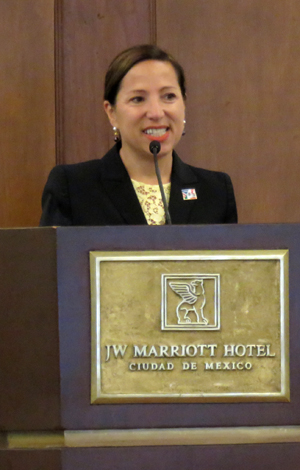
Ambassador Eleni Kounalakis, chair of the California Advisory Council for International Trade and Investment, was the first speaker to be introduced. She thanked the Governor’s Office of Business Development (GO-Biz), adding that the office plays an important role in achieving the goals of increasing trade and investment in California. The Ambassador urged the present business delegation to submit their input, saying that the office needs to hear from the business community on how to increase exports and direct investment into California.
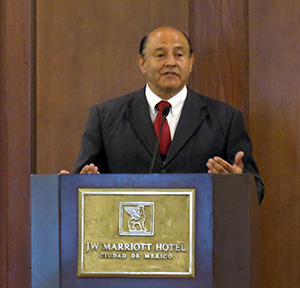
Senator Lou Correa (D-Anaheim) spoke after Ambassador Kounalakis. He began his remarks by pointing to Disneyland, which is located in his home district. The biggest tourist group to visit Disneyland each year is from Mexico, he said. He further stressed the importance of trade with Mexico by adding that Mexico is California’s largest trading partner and that trade between Mexico and California is three times greater than trade between California and Texas. The senator referred back to the opening reception of the trade mission, when Governor Edmund G. Brown Jr. said that delegates should prepare for a “successful trade mission.” Correa asked “What does ‘successful’ mean?” He questioned how many delegates will continue to follow-up with their business contacts after the trade mission ends, but expressed hope that attendees will find their “diamond in the rough” in Mexico.
Assemblyman Jose Medina (D-Riverside) followed Correa, calling Mexico a nexus for the movement of goods. He said he calls Mexico a nexus because goods come into California and then continue on to the rest of the United States.

Top officials from the U.S. Embassy in Mexico, Dorothy Lutter, minister counselor for Commercial Services, and Kemy Monahan, minister counselor for Commercial Affairs, joined forces to answer questions from the delegation concerning business operations in Mexico. Lutter also gave a PowerPoint presentation (available under the “Documents/Resources” tab above), where she dispelled misconceptions regarding manufacturing in Mexico. For example, she mentioned that Mexico is the fourth largest provider of IT services in the world and that the aviation sector in the country is booming.
Caroline Beteta, president and CEO of Visit California, also spoke at the briefing and played a few of the promotional videos that Visit California has created to market California as a top destination to visitors. Tourism is a very competitive industry because it is so lucrative, Beteta said. Luckily, tourism in California is booming—it is the most visited state in the country. Even though tourism is a service, it is still considered an export and is factored into the state’s GDP. Every year, travelers pump nearly $110 billion into California’s economy.
Air travel is the key target of Visit California’s marketing, as air travelers spend three times as much money as a ground transportation travelers do. The average Mexican air traveler will spend the equivalent value of 500 pounds of exported almonds.
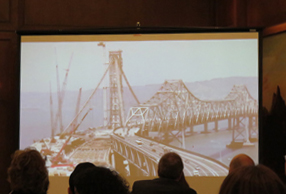
Caroline Beteta’s PowerPoint presentation can be found under the “Documents/Resources” tab above.
For more information on Visit California, please visit www.visitcalifornia.com.
After the breakfast briefing, the delegation headed to the Ministry of Foreign Affairs where Mary Nichols, president of the California Air Resources Board, and a panel of experts discussed climate change and the importance of a strong collaborative relationship between Mexico and United States. The panel consisted of: Juan Carlos Belausteguigoita Rius, executive director of the Mario Molina Center; Nathaniel Keohane, vice president of International Climate at the Environmental Defense Fund; Rodolfo Lacy Tamayo, undersecretary for planning and environmental policy at the Ministry of Environment and Natural Resources (SEMARNAT).
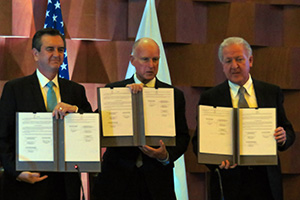
(From left) Undersecretary Lacy, Governor Brown, and General Director Rescala
After this high-level dialogue, Governor Edmund G. Brown Jr.; Undersecretary Lacy; and General Director Jorge Rescala, National Forestry Commission of Mexico, ascended the stage to sign a memorandum of understanding (MOU) to combat climate change. The agreement lists a range of joint activities to reduce greenhouse gases, collaborate on strategies to respond to fires along the border, improve air quality and expand markets for clean energy strategies, and strengthen fuel and truck efficiency standards and support green freight initiatives.
Before signing the MOU, Undersecretary Lacy said that Mexico and California have a long history of environmental cooperation.
“The agreement signed today will take our joint work to a whole new level of cooperation, which will reflect in tangible and concrete results that will inure to our mutual benefit,” he said.
After witnessing the MOU signing, some delegates chose to attend one of the cultural events of the trade mission: a visit to the Cathedral of the Assumption of Mary. It is the largest cathedral in the Americas and the seat of the Archdiocese of Mexico.
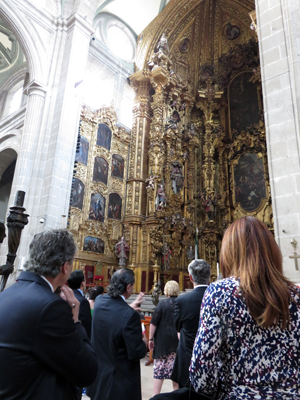
During the day, Governor Brown met privately with President of Mexico Enrique Peña Nieto. After the meeting, Governor Brown announced that President Nieto accepted his invitation to visit California.
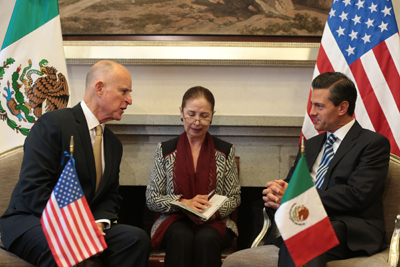

In the evening, delegates headed to the Soumaya Museum for a match-making evening reception with Mexican business leaders and investors gathered by the U.S. Foreign Commercial Service and partners in Mexico. Governor Brown and Ambassador E. Anthony Wayne both made remarks. In addition, the event sponsor AES, was represented by Ken Zagzebski, president, United States Strategic Business Unit, AES Corporation, which handles major electrical generation in Southern California.
The Museo Soumaya is a private museum in the Nuevo Polanco area of Mexico City. It has a collection of more than 66,000 pieces of art. The majority of the art consists of European works from the 15th to the 20th century. It also holds Mexican art, religious relics, historical documents and coins. The museum contains the world’s largest collection of pre-Hispanic and colonial era coins. It also holds the largest collection of casts of sculptures by Auguste Rodin outside of France.
After the reception, delegates and some members of the California legislature attended an evening dinner at the Hacienda de los Morales. Iron Horse Ranch and Vineyards gifted the sparkling wine at this dinner.


